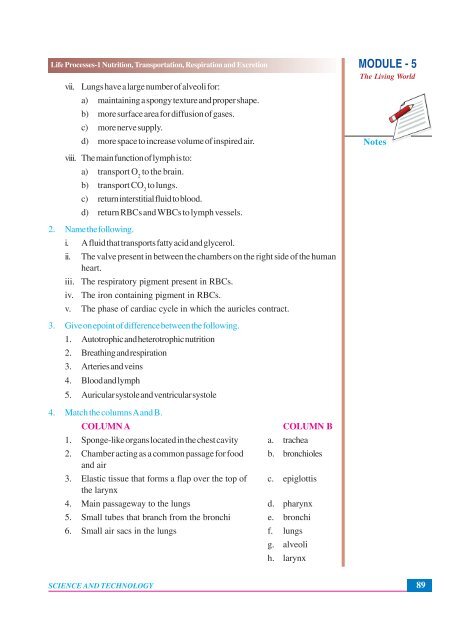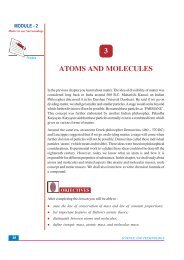Nutrition, Transportation, Respiration and Excretion
Nutrition, Transportation, Respiration and Excretion
Nutrition, Transportation, Respiration and Excretion
You also want an ePaper? Increase the reach of your titles
YUMPU automatically turns print PDFs into web optimized ePapers that Google loves.
Life Processes-1 <strong>Nutrition</strong>, <strong>Transportation</strong>, <strong>Respiration</strong> <strong>and</strong> <strong>Excretion</strong><br />
vii. Lungs have a large number of alveoli for:<br />
a) maintaining a spongy texture <strong>and</strong> proper shape.<br />
b) more surface area for diffusion of gases.<br />
c) more nerve supply.<br />
d) more space to increase volume of inspired air.<br />
MODULE - 5<br />
The Living World<br />
Notes<br />
viii. The main function of lymph is to:<br />
a) transport O 2<br />
to the brain.<br />
b) transport CO 2<br />
to lungs.<br />
c) return interstitial fluid to blood.<br />
d) return RBCs <strong>and</strong> WBCs to lymph vessels.<br />
2. Name the following.<br />
i. A fluid that transports fatty acid <strong>and</strong> glycerol.<br />
ii. The valve present in between the chambers on the right side of the human<br />
heart.<br />
iii. The respiratory pigment present in RBCs.<br />
iv. The iron containing pigment in RBCs.<br />
v. The phase of cardiac cycle in which the auricles contract.<br />
3. Give on epoint of difference between the following.<br />
1. Autotrophic <strong>and</strong> heterotrophic nutrition<br />
2. Breathing <strong>and</strong> respiration<br />
3. Arteries <strong>and</strong> veins<br />
4. Blood <strong>and</strong> lymph<br />
5. Auricular systole <strong>and</strong> ventricular systole<br />
4. Match the columns A <strong>and</strong> B.<br />
COLUMN A<br />
COLUMN B<br />
1. Sponge-like organs located in the chest cavity a. trachea<br />
2. Chamber acting as a common passage for food b. bronchioles<br />
<strong>and</strong> air<br />
3. Elastic tissue that forms a flap over the top of c. epiglottis<br />
the larynx<br />
4. Main passageway to the lungs d. pharynx<br />
5. Small tubes that branch from the bronchi e. bronchi<br />
6. Small air sacs in the lungs f. lungs<br />
g. alveoli<br />
h. larynx<br />
SCIENCE AND TECHNOLOGY<br />
89
















